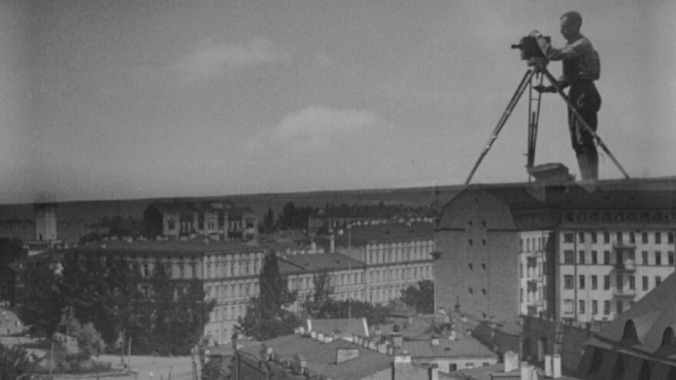Man with a Movie Camera Found the Mechanical Heartbeat of the Modern World

“Cinematography” must die so that the art of cinema may live. WE call for its death to be hastened.—Dziga Vertov, 1922 “WE: VARIANT OF A MANIFESTO”
When the Bolsheviks overthrew the old order in those “10 days that shook the world” in 1917, they aimed for the revolution to be in all aspects of social life. Two years later, Vladimir Lenin declared, “The cinema is for us the most important of the arts.” Indeed, the Soviets replaced the Lumière travelogues that went from town to town with agit-trains, running the rails of a war-torn Russia armed with communist libraries and movie theater cars playing propaganda newsreels. It was in these agit-prop newsreels that one of cinema’s greatest revolutionary soldiers, one of the truest ideologues and believers in a holistic cinematic revolution came of age.
In 1918, the journalist Mikhail Koltsov invited a 22 year-old Denis Kaufman to join the Moscow Committee for Cinematography to make newsreels for the party. Kaufman had previously run an experimental sound studio, and taken a keen interest in emerging technology and its relationships to avant-garde art. Kaufman would act as a principal collaborator on the Kino-Nedelya (Film-Week) series that ran on Mikhail Kalinin’s famed agit-train October Revolution, before himself directing his own non-fiction works. Kaufman’s futurist and constructivist inspirations led to extraordinary avant-garde resolve in his works, both in filmmaking and writing. In 1922 he’d seek to spread his influence by founding a monthly magazine Kino-Pravda (Film-Truth named after the Communist Party’s primary publication Pravda), and he became most well-known by his nom-de-plume: Dziga Vertov, a name that roughly translates to “Spinning Top,” onomatopoeically referencing the motion of film running through a camera or projector.
Vertov and his Council of Three (made up of himself, his brother/cameraman Mikhail Kaufman, and his wife/editor Elizaveta Svilova) turned out to be too formally radical for the incredibly radical moment they found themselves trying to shape, and by the time they premiered their masterpiece in Moscow during April 1929, they had started to alienate their revolutionary peers. Yet 95 years later, Man with a Movie Camera persists as one of the definitive statements on non-fiction filmmaking in all of cinema history, still as stunning as the day it was released.
Before even the city sleeps, the movie theater does. A projectionist enters and awakens the world. Chairs fold themselves down and invite the masses to sit on them. The people shuffle in. The projectionist pushes the two carbon rods in the projector together, shooting light through the film and onto the screen as they arc with electricity. Cinema is a crude and beautiful modern machine. We now see the somnolent city, not one particular city, but a few (Odessa, Kharkiv, Kiev) threaded together to make up the idea of “city.” Just as film compelled the people to enter the theater, its manipulation of time compels the city to come to life. It is a kind of destiny the camera presents that is often more subtly alluded to, like how John Ford’s camera in the opening shot of The Searchers gently pushes Martha out the door and into the western landscape, or how Jean-Luc Godard’s panning gives way to tracking Fritz Lang as he approaches the image that will cause the marriage at the center of Contempt to fall apart—the motion, the movement inherent to cinema and the machine behind it, is its ultimate power. Man with a Movie Camera is one the most overt explorations of this concept in the medium’s history.
Under the perfect gaze of Vertov’s mechanical kino-eye, the world is revealed rather than created. There is nothing in front of the camera that the human eye theoretically could not catch, but the movie camera captures it all, trapping time and space for eternity, to be paused and played back again and again. In this sense, Man with a Movie Camera is found as much as it is created—the kinok (“kino-eye man,” Vertov’s alternative to the idea of a “cinematographer”) fossilizes the world in silver nitrate for another to construct a new reality out of it in the editing room. Images of machines are gathered, and then the editor puts them together to reveal the pattern of their rhythm. Man with a Movie Camera is as much a symphony of machines as it is of a city, itself becoming a machine through the observation of Kaufman’s camera and Svilova’s editing. The patterns of images repeat themselves, revealing the many connections of modern life through their speed and motion: The carouseling of motorcycles around a banked curve mirrors the literal carouseling of a person at a carnival. The world spins from a new view by way of the machines we’ve created.
Unlike Vertov’s contemporaries, scenes are not staged, but discovered—the unfolding of the world becoming the stone to carve the film from rather than using stages and actors to mold a picture out of clay. Vertov railed against his contemporaries using motion pictures like “a mere literary skeleton covered with a film-skin” in his 1923 article “On the Significance of Nonacted Cinema:”
-

-

-

-

-

-

-

-

-

-

-

-

-

-

-

-

-

-

-

-

-

-

-

-

-

-

-

-

-

-

-

-

-

-

-

-

-

-

-

-








































